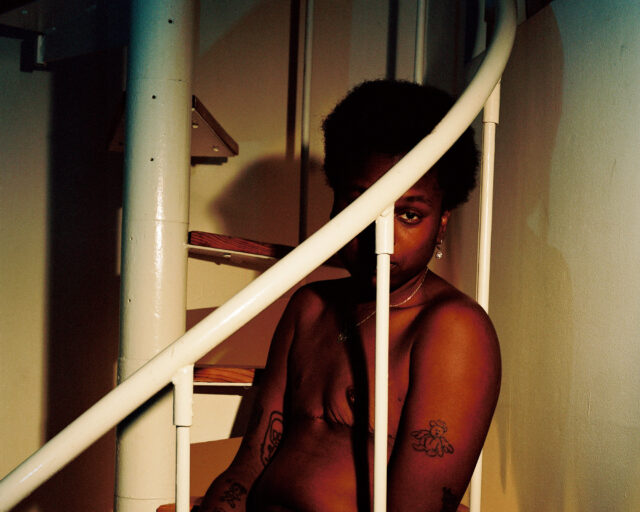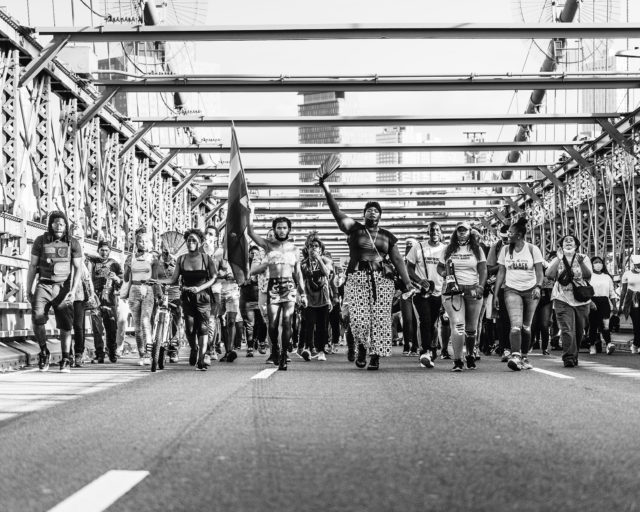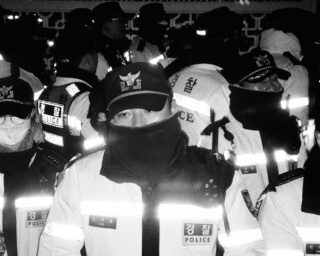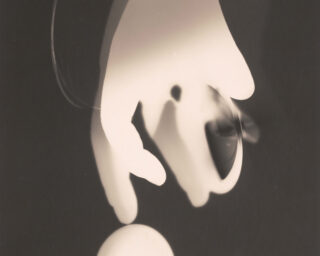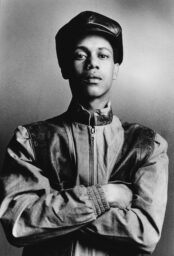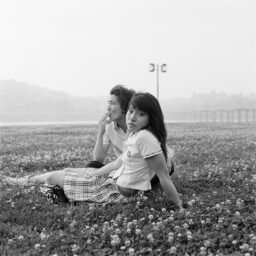Mariette Pathy Allen, Valerie, scientist with many patents, 1985
Mariette Pathy Allen didn’t initially set out to photograph members of the transgender community. As she remembers it, they found her. In 1978, while visiting New Orleans with her husband, she noticed a group of cross-dressers in the hotel where she was staying. When she approached them with her camera, she instantly connected with one person in particular: a trans woman named Vicky West. Allen describes her meeting with West as an epiphany; their resulting friendship opened the door to a career documenting, with gentle reverence, the lives of gender-nonconforming people around the world, from trans communities in the United States, to, more recently, “spirit mediums” in Burma and Thailand.
Allen’s first book, Transformations: Crossdressers and Those Who Love Them (1989), portrays cross-dressers and their families. In those years, when gender variance was deeply stigmatized, Allen offered a vital and revelatory portrait of trans and gender-variant lives. Thirty years later, Allen continues to photograph communities around the world where the blurring of normally rigid gender lines is accepted, and even embraced. Between 2012 and 2014, she photographed a community of transgender women in Cuba. The resulting images were published in TransCuba (2014). Her most recent work, Transcendents (2017), explores a growing subculture of gender nonconforming men who act as “spirit mediums” in Burma and Thailand.
Compassionate without being sentimental, Allen’s photographs challenge our conceptualization of gender, and serve as a counternarrative to the often sensational and exploitative depictions of transgender lives in the media. Upon the release of Aperture’s “Future Gender” issue, which features a portfolio of Allen’s poignant, 1980s-era portraits, I spoke with Allen about her photography career, and the experiences that have shaped it.

Katie Booth: You first encountered the gender nonconforming community by chance in 1978, in New Orleans. As a cisgender photographer, what made you gravitate towards them?
Mariette Pathy Allen: On the last day of Mardi Gras, I was invited to join a group of incredible-looking people for breakfast at our hotel. At the time, I didn’t know anything about gender variance. All I knew was that I was hearing loud, masculine sounding voices and seeing people wearing wigs, ball gowns, earrings, eyelashes, and heels. After breakfast, they lined up on one side of the swimming pool, ready to be photographed by the group’s leader. As I raised my own camera to my eyes, I looked deep into the eyes of the person standing in the middle of the group. I felt as if I weren’t looking at a man or a woman, but at the essence of a human being. I said to myself as I took the picture, “I have to have this person in my life.”
Booth: How did that experience shape your concept of gender?
Allen: I knew nothing about gender variance, but I’ve always been puzzled by society’s rules. How, when, and why did our culture decide that women are supposed to be one way, and men another? It always struck me as odd. I had the great good luck to study anthropology in high school. I was so relieved when I realized: “Wait a minute, those are just our culture’s interpretations! There are many other ways of living, and many other interpretations of what it means to be human.” When I met Vicky West, I came into direct contact with a different way of experiencing gender. I was excited by the flexibility and playfulness around gender, by seeing typical gender roles dissolve in front of my eyes! It felt like escaping the prison of rules.

Booth: You forge close friendships and connections with the people you photograph. How do you balance the personal and anthropological in your work?
Allen: I have always been fascinated by how people live their lives. I try to create an environment where people are comfortable enough to reveal their essence, to go beyond their “corporate look,” if I can put it that way. Beyond that, I look for details, for beauty. What is the light doing on this face? What is the shape they’re sitting in? What emotion comes through, based on these details? What environment feels right, or how does the environment relate to this person? I feel like I’m reading and writing at the same time.
Booth: At that time, the transgender community was far less visible than it is today. What questions were you asking yourself as a photographer with regard to how you portrayed your subjects?
Allen: When I first started, and well into the ’90s, I encountered cross-dressers who grew up feeling very bad about themselves. Many thought they were the only ones in the world who felt the way they did. Some thought they were insane. Many were ashamed of themselves or terrified of being discovered. They kept their secret from their spouses, children, and other family members. I discovered, pretty early on, that I could make a difference in the lives of crossdressers and their families through photography. It could actually help a lot of people. This realization gave me a new sense of purpose, and a lot of joy.

Booth: When did you discover that your photographs could be helpful?
Allen: As I photographed male to female cross-dressers, I worked out ways of changing their relationship to movement and space, in order to develop an appreciation of their feminine character. While they were working on the emotional aspects of transforming themselves, I had to figure out how to handle issues related to wigs, makeup, clothes, backdrops, and other aspects of the journey that I had never considered.
In 1989, when my first book, Transformations, was released, it was received with joy and relief by the “community.” This was the book that they had been looking for when they were growing up. Transformations was the book that many people used to tell their family and friends who they were. I’ve been told that it saved marriages, and saved lives. At that time, however, the art community wasn’t all that impressed, but gender non-conforming people were ecstatic over it.
Booth: How was your work different from other portrayals of transgender people that existed at the time?
Allen: Gender-variant people were often depicted as freaks, evil, dangerous, or crazy people. They were usually photographed alone, always the “other,” and never as lovable people. A lot of media coverage focused on shock value. They also enjoyed outing gender nonconformists. I always wanted to show them in the daylight, in everyday life, to make them feel relatable.

Booth: Tell me about the “fantasy shoots” you did.
Allen: Many cross-dressers were involved in very typically masculine work: police officers, truck drivers, or in the military, for example. When somebody would pose, it would be like standing there for a passport picture, totally symmetrical. I would try to help them figure out what kind of woman they wanted to be, and encourage them to act as that person. It was a combination of trying to get more at the essence of a person. You can see in the pictures in Aperture: they don’t all look happy, but I think they do look true to themselves.
Booth: The first picture of yours that appears in “Future Gender,” of Valerie, really struck me as an unguarded moment.
Allen: Yes, we went up in the dunes in Provincetown. Valerie brought fancy clothes, and we created a great variety of photographs, playing with ideas of sex and glamour. By sunset, it was getting cold and Valerie was tired. She grabbed her fur coat, hugging it to herself. She looked like was a little girl, holding her teddy bear.

Booth: I’d like to shift focus to your work in Burma and Thailand. In her preface to Transcendents, Zackary Drucker writes, “To see trans folks living among their fellow country-people, fully integrated into the fabric of their communities and living openly, is a tremendous global model for all of us moving into the future.” Tell me more about how spirit mediums—people who channel spirits—fit within their communities.
Allen: I completely agree with Zackary. To be free from making choices according to the binary, in a society that appreciates you for who you are, is otherworldly! I asked Tun, a spirit medium, “How do you see yourself? As a man, as a woman?” And she said, “I don’t care, whatever.”
Booth: That would be a bold statement in a lot of places.
Allen: Yes. And I only say “she,” because I saw her presenting as a woman a lot, but it seemed to be irrelevant to the spirit medium community. In Burma and Thailand, Spirit Mediums can be cisgendered women, or (primarily) gay men, or transgender women. The work they do is a contribution to what their community needs, so they are held in high regard. Although both Burma and Thailand are homophobic and transphobic countries, gay and transgender spirit mediums are safe and accepted as they are.

Booth: Can you give an example of a spirit medium whose work extended beyond actively channeling a spirit?
Allen: One time I went to visit a nursing home with a spirit medium. People were very sick, and the air conditioning was gone. The spirit medium borrowed a big fan from the nurses, and began greeting and fanning the sick individuals. She was participating in the community as a helpful citizen as well as during times when possessed by her spirit.
Booth: Do you think you might return to work in the United States again? There has certainly been a major cultural shift in recent years, in terms of how transgender folks are represented.
Allen: I actually have a transgender assistant who was here yesterday, when I received the “Future Gender” issue. She got all excited because she knew some of the people in it, including on the cover. When I looked through the magazine, I was inspired and thought maybe there is more I could do photographing gender variance in the U.S.

All photographs courtesy the artist
Booth: As a photographer, what ideas or concerns do you have when you think about representing the transgender community in our current political and cultural climate?
Allen: I’m not interested in photographing transgender celebrities. I’m still much more interested in regular folks and how their lives are going with all the push and pull that is being experienced now. I continue to be fascinated by the evolution of this movement. I think people are at the stage where we can really ask ourselves, What does it mean to identify as a man or a woman, or as both, or neither? I believe that it’s the gender nonconforming people who have the most to teach us.
Booth: Looking through “Future Gender,” if someone had told you when you first started making this work that your work would be presented in this context, would you have believed them?
Allen: No. I really got very little respect for this work for a long time. Galleries thought the subject too limited, and I think they didn’t find the pictures very exciting because my images de-sensationalized the subject matter. I have never thought that gender variance was a narrow subject. I think it refers to all of us, at any time. The questions about identity may seem to be simpler for those of us who are cisgender. But, as time goes on, and rigid gender roles continue to loosen, we might all be dealing pretty equally with those little internal voices that say to us: Who are you, anyway?
Mariette Pathy Allen’s Transcendents: Spirit Mediums in Burma and Thailand was published by Daylight in fall 2017. Read more about Mariette Pathy Allen in Aperture Issue 229, “Future Gender.”











